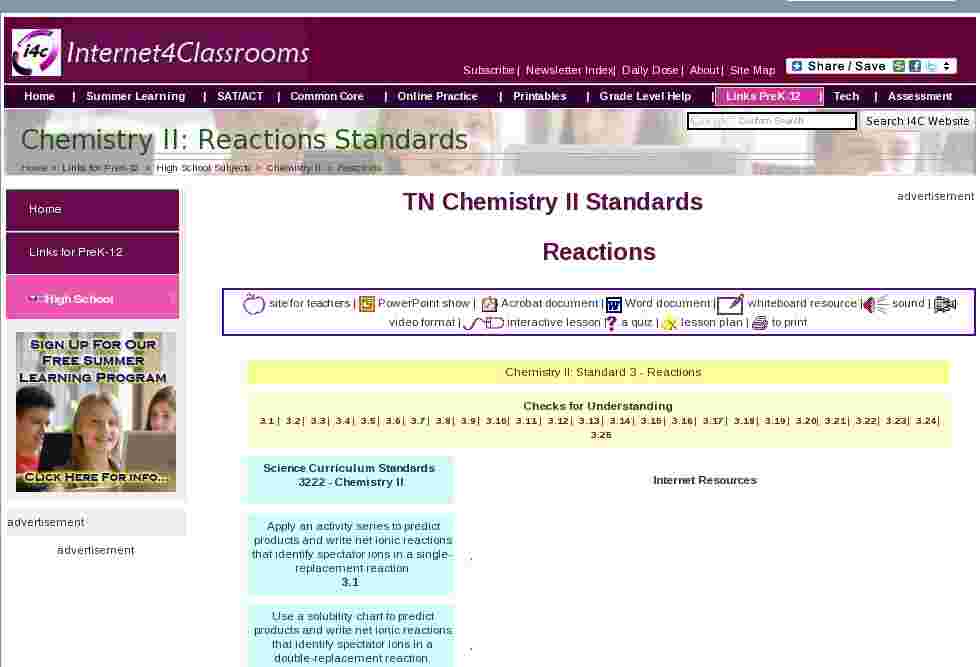Chemistry II: Standard 3 - Reactions |
|
Science Curriculum Standards
3222 - Chemistry II
|
Internet Resources |
Apply an activity series to predict products and write net ionic reactions that identify spectator ions in a single-replacement reaction.
3.1 |
|
Use a solubility chart to predict products and write net ionic reactions that identify spectator ions in a double-replacement reaction.
3.2 |
|
Identify the oxidation states of ions in an oxidation-reduction reaction.
3.3 |
|
Balance an oxidation-reduction reaction performed in neutral, acidic, or basic environments.
3.4 |
|
Use reduction potentials to determine the anode and cathode reactions in an electrochemical cell, and calculate its standard reduction potential.
3.5 |
|
Apply reduction potentials to identify oxidizing and reducing agents and determine their relative strengths.
3.6 |
|
Calculate the number of moles, mass, number of ions, atoms, and molecules, volume, and pressure of reactants and products in a chemical reaction based on appropriate constants and quantitative information about reaction components.
3.7 |
|
Calculate the amount of remaining reactants and products in which one of the reactants is limiting.
3.8 |
|
Calculate the rate of a chemical reaction based on elapsed time and amount of remaining reactant or product.
3.9 |
|
Use the rate law and rate of reaction to calculate and interpret the rate constant of a chemical reaction.
3.10 |
|
Calculate and interpret the reaction order based on the rate constant and concentration of reactants or products at various times during the reaction.
3.11 |
|
Draw energy profiles for catalyzed and uncatalyzed chemical reactions in terms of activation energy.
3.12 |
|
Write an equilibrium expression and calculate the equilibrium constant based on the concentration of reactants and products at equilibrium.
3.13 |
|
Interpret the magnitude of the equilibrium constant to determine equilibrium concentrations and direction of a chemical reaction that has yet to reach equilibrium.
3.14 |
|
Apply Le Chatelier’s Principle to predict shifts in the direction of a chemical reaction in response to changes in temperature, pressure and concentration of reactants or products.
3.15 |
|
Calculate the percent ionization and pH of a solution given the identity, concentration, and acid/base dissociation constant of an acid or base.
3.16 |
|
Prepare a buffer of a specific pH and calculate the change in pH in response to addition of additional acid or base.
3.17 |
|
Perform a titration of a weak acid or weak base identifying the Ka or Kb and the pH at the equivalence point.
3.18 |
|
Characterize the strength of acids and bases by exploring their chemical structures.
3.19 |
|
Calculate the solubility product constant based on the concentration of soluble ions.
3.20 |
|
Interpret the magnitude of the solubility product constant in terms of the solubility of the substance.
3.21 |
|
Apply thermodynamic data to calculate the change in enthalpy, entropy, and Gibb’s free energy of a chemical reaction.
3.22 |
|
Interpret the magnitude of the enthalpy and entropy change of a chemical reaction in terms of heat changes and order of the reaction components.
3.23 |
|
Interpret the magnitude of free energy hange in terms of spontaneity of the chemical reaction.
3.24 |
|
Relate the magnitude of the free energy change to the equilibrium condition and reduction potential of a chemical reaction.
3.25 |
|
site for teachers |
PowerPoint show |
Acrobat document |
Word document |
whiteboard resource |
sound |
video format |
interactive lesson |
a quiz |
lesson plan |
to print

 Custom Search
Custom Search